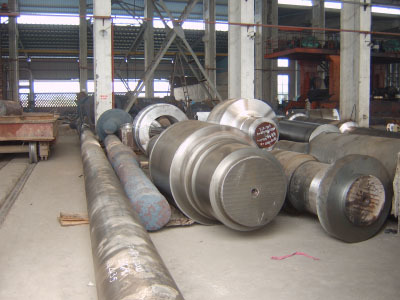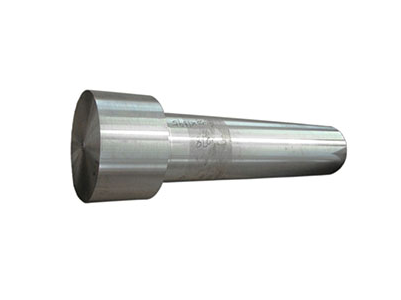Understanding the Strength Properties of Open-Die Forged Shafts: A Comprehensive Guide
Release Time:
Nov 05,2025
Understanding the Strength Properties of Open-Die Forged Shafts Table of Contents 1. Introduction to Open-Die Forging 2. The Open-Die Forging Process Explained 2.1 Steps in Open-Die Forging 2.2 Material Selection for Forged Shafts 3. Strength Properties of Open-Die Forged Shafts 3.1 Mechanical Properties Overview

Understanding the Strength Properties of Open-Die Forged Shafts
Table of Contents
- 1. Introduction to Open-Die Forging
- 2. The Open-Die Forging Process Explained
- 3. Strength Properties of Open-Die Forged Shafts
- 3.1 Mechanical Properties Overview
- 3.2 Tensile Strength and Ductility
- 3.3 Fatigue Resistance and Impact Toughness
- 4. Applications of Open-Die Forged Shafts
- 5. Advantages of Open-Die Forged Shafts
- 6. Open-Die vs. Closed-Die Forging: A Comparison
- 7. Future Trends in Open-Die Forging
- 8. Conclusion
- 9. Frequently Asked Questions (FAQs)
1. Introduction to Open-Die Forging
Open-die forging, a crucial process in the manufacturing of various industrial components, is renowned for its ability to produce high-performance parts, particularly shafts. The process involves shaping metal using flat dies without complete enclosure, allowing for significant deformation and greater control over the material properties. This article delves into the strengths of open-die forged shafts, outlining their manufacturing process, strength characteristics, applications, and advantages.
2. The Open-Die Forging Process Explained
Open-die forging involves several critical steps that ensure the production of high-quality shafts. Understanding these steps is essential for appreciating the resulting strength properties.
2.1 Steps in Open-Die Forging
The open-die forging process can be broken down into several key stages:
1. **Heating the Material**: The chosen metal is heated to a specific temperature, typically between 1,200°F and 2,300°F, depending on the material. This heating enhances workability.
2. **Deformation**: The heated metal is then placed between two flat dies, where it undergoes deformation through repeated hammering or pressing. The operator must skillfully manipulate the metal's position to ensure uniform deformation.
3. **Cooling**: After achieving the desired shape, the forged shaft is allowed to cool. This cooling process can affect the material's microstructure, further influencing its strength properties.
4. **Finishing**: Additional processes such as machining or surface treatment may be applied to meet specific dimensional and finish requirements.
2.2 Material Selection for Forged Shafts
Choosing the right material is crucial for maximizing the strength properties of open-die forged shafts. Common materials include carbon steel, alloy steel, and stainless steel. Each material offers distinct advantages depending on the intended application, with alloy steels often providing enhanced strength and toughness.
3. Strength Properties of Open-Die Forged Shafts
The strength properties of open-die forged shafts are notable for their superior performance characteristics, making them ideal for demanding applications.
3.1 Mechanical Properties Overview
Mechanical properties are defined by how a material behaves under various forces and conditions. Open-die forged shafts typically exhibit:
- **High tensile strength**: Resistance to being pulled apart.
- **Enhanced ductility**: Ability to deform without breaking.
- **Excellent fatigue resistance**: Ability to withstand cyclic loading.
3.2 Tensile Strength and Ductility
Tensile strength measures the maximum amount of tensile (pulling) stress a material can withstand before failure. Open-die forged shafts show significantly higher tensile strength compared to their cast or machined counterparts. The deformation process aligns the grain structure of the metal, resulting in improved tensile properties.
Ductility is equally important; it allows the shafts to absorb energy and deform under stress without fracturing. This resilience is vital in applications requiring repeated load cycles, such as in automotive drivetrains.
3.3 Fatigue Resistance and Impact Toughness
Fatigue resistance refers to a material's ability to endure repeated loading cycles without failure. Open-die forged shafts excel in this area due to their refined microstructure and uniform grain flow, which reduce stress concentration points.
Impact toughness is another essential property, indicating how well a material can absorb energy during sudden impacts. Open-die forged shafts are designed to withstand significant impacts without fracturing, making them suitable for high-stress applications.
4. Applications of Open-Die Forged Shafts
Open-die forged shafts find extensive applications across various industries due to their exceptional strength properties:
- **Automotive Industry**: Used for drive shafts, axles, and suspension components due to their ability to handle high torque and stress.
- **Aerospace**: Ideal for critical components that require high strength-to-weight ratios.
- **Oil and Gas**: Utilized in drilling and extraction equipment where durability and reliability are paramount.
- **Heavy Machinery**: Components in construction and agricultural machinery benefit from the strength and toughness of forged shafts.
5. Advantages of Open-Die Forged Shafts
Open-die forging offers numerous advantages, making it a preferred method for manufacturing high-performance shafts:
1. **Enhanced Strength Properties**: The forging process aligns the grain structure, improving strength and ductility.
2. **Design Flexibility**: Open-die forging allows for the production of large and complex shapes that would be challenging to achieve through other methods.
3. **Reduced Material Waste**: Compared to casting, open-die forging minimizes material waste, leading to more sustainable manufacturing practices.
4. **Improved Fatigue Resistance**: The resulting microstructure provides excellent fatigue resistance, extending the lifespan of components.
5. **Cost-Effective for Large Runs**: While initial setup costs can be higher, open-die forging becomes cost-effective for large production runs due to reduced material waste and increased speed of manufacturing.
6. Open-Die vs. Closed-Die Forging: A Comparison
While both open-die and closed-die forging produce high-strength components, there are distinct differences between the two methods:
- **Tooling**: Closed-die forging uses dies that completely enclose the material, whereas open-die forging requires only flat dies.
- **Production Volume**: Open-die forging is more suitable for low to medium production volumes, while closed-die forging is more efficient for large-scale production.
- **Cost**: Open-die forging typically incurs lower die production costs, making it favorable for custom or low-volume applications.
7. Future Trends in Open-Die Forging
The future of open-die forging is being shaped by advancements in technology and materials science:
- **Automation and Robotics**: Increased automation in the forging process leads to greater consistency and efficiency.
- **Advanced Alloys**: Research into new alloy compositions promises to enhance the strength and durability of forged shafts.
- **Sustainability**: Efforts to reduce energy consumption and material waste are driving innovations in forging practices.
8. Conclusion
Open-die forged shafts represent a pinnacle of engineering excellence, characterized by their superior strength properties and versatility in applications. Their manufacturing process not only produces high-performance components but also offers significant advantages over traditional methods. As industries continue to evolve, the role of open-die forging will remain critical, driving advancements in strength, durability, and efficiency.
9. Frequently Asked Questions (FAQs)
1. What materials can be used for open-die forging?
Open-die forging can utilize a variety of materials, including carbon steels, alloy steels, and stainless steels, depending on the desired properties and application.
2. How does the open-die forging process compare to closed-die forging?
Open-die forging involves the use of flat dies and allows for greater flexibility in shape, whereas closed-die forging uses dies that completely enclose the material, which is more suited for high-volume production.
3. What are the benefits of using open-die forged shafts in the automotive industry?
Open-die forged shafts offer enhanced strength, durability, and fatigue resistance, making them ideal for components that endure high stress and torque in automotive applications.
4. How does temperature affect the forging process?
Heating the material to the appropriate temperature enhances its workability, allowing for easier deformation and improved mechanical properties.
5. What future trends are expected in the open-die forging industry?
Future trends include advancements in automation, the use of new alloy compositions, and a focus on sustainability to reduce waste and energy consumption in the forging process.
多行文本内容元素
富文本内容绑定数据后可解析HTML语言内容
Key words:
News Hotspot








